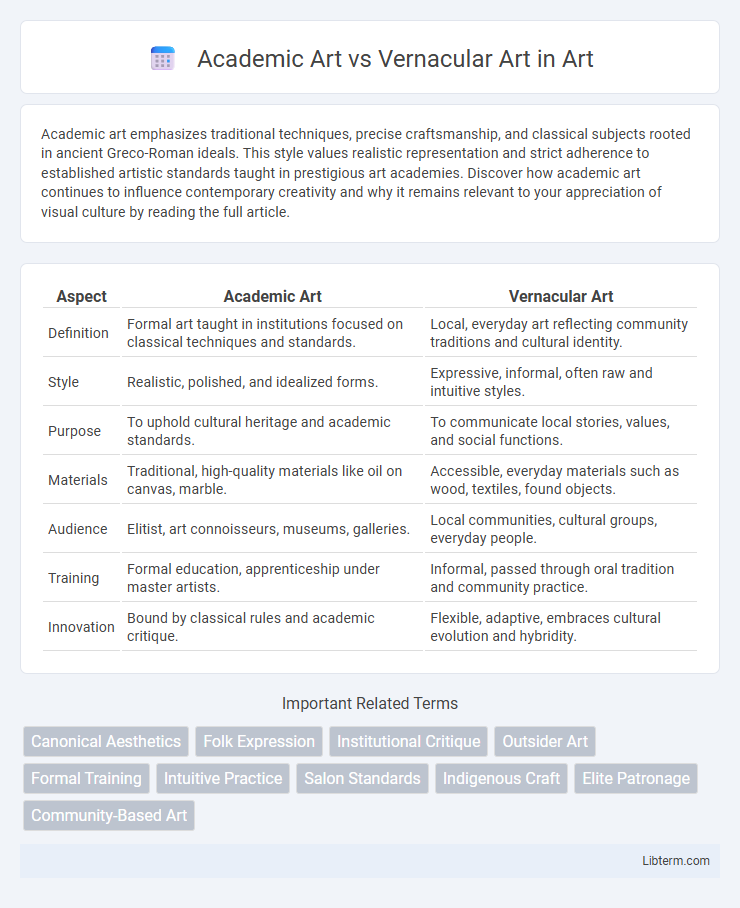Academic art emphasizes traditional techniques, precise craftsmanship, and classical subjects rooted in ancient Greco-Roman ideals. This style values realistic representation and strict adherence to established artistic standards taught in prestigious art academies. Discover how academic art continues to influence contemporary creativity and why it remains relevant to your appreciation of visual culture by reading the full article.
Table of Comparison
| Aspect | Academic Art | Vernacular Art |
|---|---|---|
| Definition | Formal art taught in institutions focused on classical techniques and standards. | Local, everyday art reflecting community traditions and cultural identity. |
| Style | Realistic, polished, and idealized forms. | Expressive, informal, often raw and intuitive styles. |
| Purpose | To uphold cultural heritage and academic standards. | To communicate local stories, values, and social functions. |
| Materials | Traditional, high-quality materials like oil on canvas, marble. | Accessible, everyday materials such as wood, textiles, found objects. |
| Audience | Elitist, art connoisseurs, museums, galleries. | Local communities, cultural groups, everyday people. |
| Training | Formal education, apprenticeship under master artists. | Informal, passed through oral tradition and community practice. |
| Innovation | Bound by classical rules and academic critique. | Flexible, adaptive, embraces cultural evolution and hybridity. |
Defining Academic Art: Principles and Characteristics
Academic Art is defined by its adherence to traditional techniques and classical principles established by European art academies, emphasizing realism, idealized beauty, and disciplined craftsmanship. It upholds strict compositional rules, proportion, and perspective to create harmonious and balanced works that often depict historical, mythological, or religious themes. The movement prioritizes technical skill, formal training, and the replication of established artistic standards over individual expression or contemporary subject matter.
Understanding Vernacular Art: Roots and Context
Vernacular Art emerges from everyday cultural practices and local traditions, reflecting the values, stories, and aesthetics of specific communities rather than formal academic standards. Rooted in oral histories, folk customs, and indigenous materials, Vernacular Art provides insight into social identity and collective memory, often transmitted through generations without formal training. Understanding Vernacular Art requires examining its contextual significance within its originating culture, highlighting its role in preserving and expressing community heritage outside mainstream institutional frameworks.
Historical Origins of Academic Art
Academic Art originated during the Renaissance period, heavily influenced by classical antiquity and the formal training methods established in European art academies such as the Academie Royale de Peinture et de Sculpture in France. It emphasized strict adherence to established techniques, proportion, and idealized subject matter, often prioritizing mythological, historical, and religious themes. This tradition contrasted sharply with Vernacular Art, which developed organically within local cultures, reflecting everyday life and cultural identity without formal institutional constraints.
The Evolution of Vernacular Art Traditions
Vernacular art traditions have evolved by integrating local customs, materials, and techniques, distinguishing themselves from the formal conventions of Academic Art that emphasize classical training and universal standards. These grassroots art forms reflect the lived experiences and cultural identity of specific communities, often adapting dynamically to social changes and technological advancements. The evolution of vernacular art highlights the increasing recognition of diverse artistic expressions beyond institutional frameworks, contributing to a richer global art landscape.
Techniques and Materials: A Comparative Analysis
Academic Art employs traditional techniques such as precise brushwork, chiaroscuro, and linear perspective, predominantly using oil paints on canvas or wood panels to achieve realistic and idealized representations. Vernacular Art utilizes locally sourced, often unconventional materials like clay, textiles, or found objects, with techniques rooted in cultural practices, including hand-weaving, carving, and folk painting, emphasizing community expression over strict realism. The contrast in materials and methods reflects Academic Art's formal training and institutional standards versus Vernacular Art's grassroots origins and functional, symbolic purposes.
Social Functions: Elitism vs. Community Expression
Academic Art traditionally serves elitist functions by reinforcing dominant cultural values and catering to institutionalized tastes within museums, galleries, and academia. Vernacular Art operates as a form of community expression, reflecting local traditions, social issues, and collective identities through accessible, everyday mediums. This distinction highlights Academic Art's role in cultural gatekeeping, whereas Vernacular Art fosters inclusivity and grassroots communication.
Aesthetics and Symbolism in Both Genres
Academic Art emphasizes formal aesthetics, adhering to classical techniques and idealized representations that convey universal themes and mythological symbolism. Vernacular Art prioritizes local cultural expression, utilizing everyday objects and motifs that resonate with community identity and popular symbolism. Both genres reflect distinct aesthetic values, with Academic Art often rooted in institutional tradition while Vernacular Art embodies grassroots creativity and symbolic relevance.
Influence of Patronage and Institutions
Academic Art flourished under the influence of formal institutions and wealthy patrons who dictated standards of technique, subject matter, and aesthetics, ensuring adherence to classical traditions and canonical styles. Vernacular Art, in contrast, emerged from local communities and everyday life, often created outside academic constraints and supported by grassroots patronage or communal appreciation. Patronage in Academic Art centralized artistic production and reinforced cultural hierarchies, while Vernacular Art reflected diverse, regional identities shaped by informal networks and popular demand.
Contemporary Perspectives on Academic and Vernacular Art
Contemporary perspectives on Academic Art emphasize its formal techniques, adherence to classical traditions, and institutional validation, highlighting its role in art education and cultural heritage preservation. Vernacular Art is increasingly valued for its grassroots origins, cultural narratives, and community engagement, reflecting diverse identities and local histories often marginalized in mainstream art discourse. Current scholarship promotes dialogue between these forms, recognizing the dynamic interplay between established academic standards and authentic vernacular expressions in shaping modern artistic landscapes.
Bridging the Divide: Fusion and Dialogue in Modern Art
Academic Art emphasizes formal techniques, classical themes, and institutional standards, while Vernacular Art reflects local traditions, everyday life, and grassroots creativity. The fusion of these art forms in modern art fosters dialogue that challenges rigid boundaries and promotes cultural inclusivity, blending high art narratives with popular expressions. Contemporary artists leverage this synthesis to innovate visually and conceptually, enriching art history through intercultural exchange and hybrid aesthetics.
Academic Art Infographic

 libterm.com
libterm.com